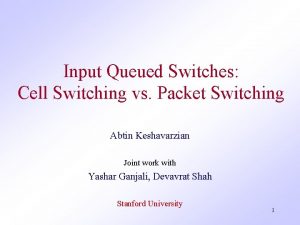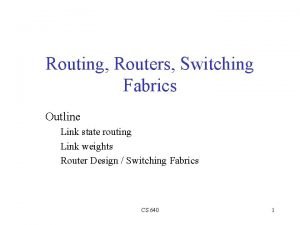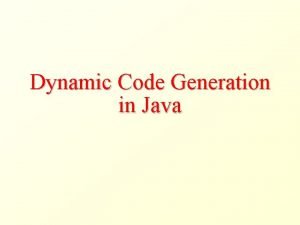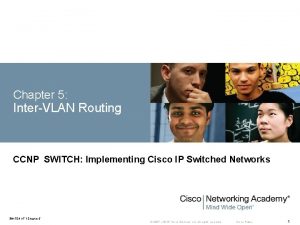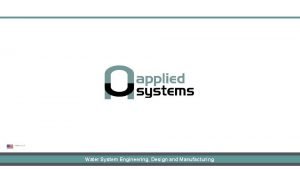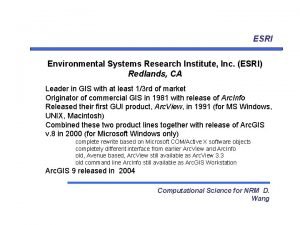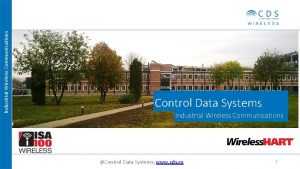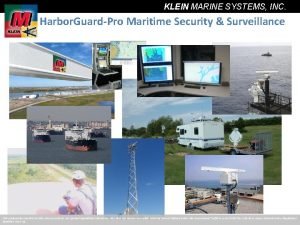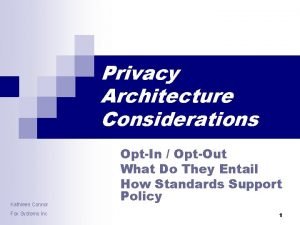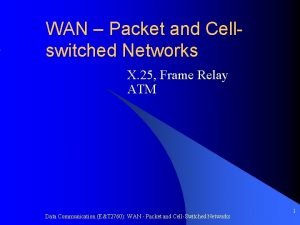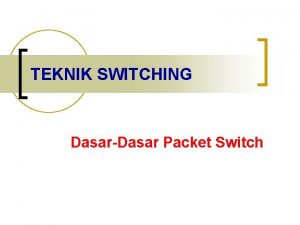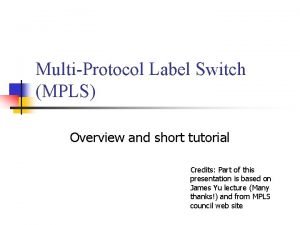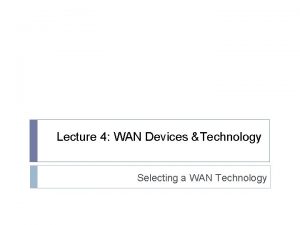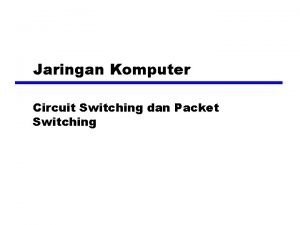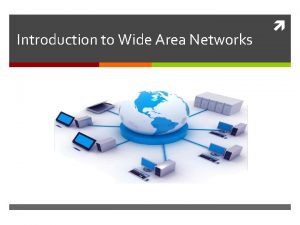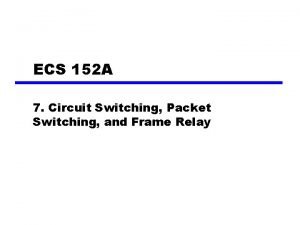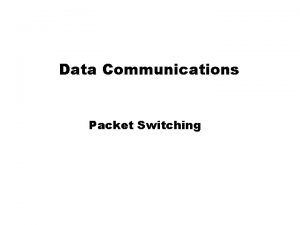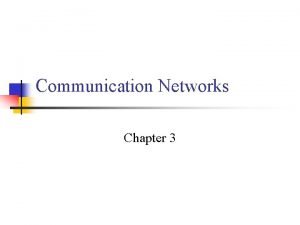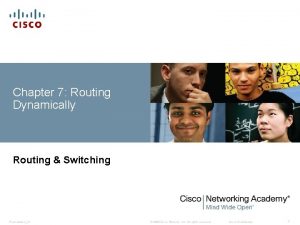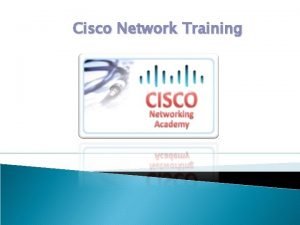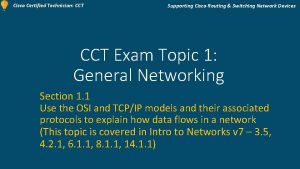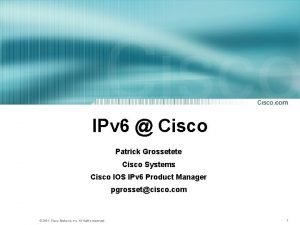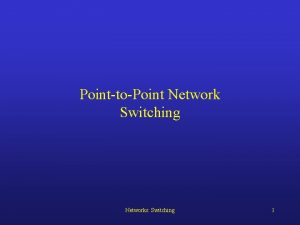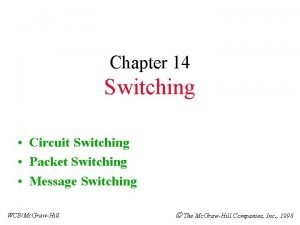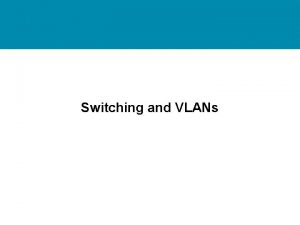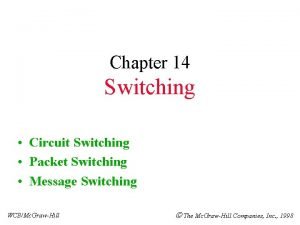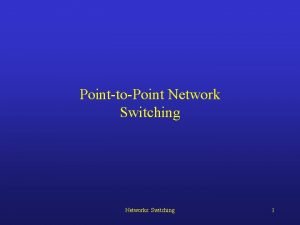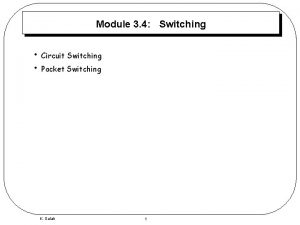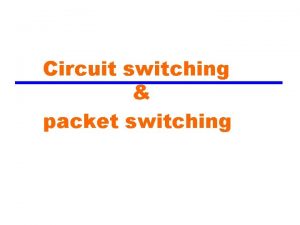Routing Dynamically Routing Switching 2007 Cisco Systems Inc



















































- Slides: 51

Routing Dynamically Routing & Switching © 2007 Cisco Systems, Inc. All rights reserved. Cisco Public 1

Dynamic Routing Protocols § Advantages of static routing -It can backup multiple interfaces/networks on a router -Easy to configure -No extra resources are needed -More secure § Disadvantages of static routing -Network changes require manual reconfiguration -Does not scale well in large topologies © 2007 Cisco Systems, Inc. All rights reserved. Cisco Public 2

Dynamic Routing Protocols § Function(s) of Dynamic Routing Protocols: • Dynamically share information between routers. • Automatically update routing table when topology changes. • Determine best path to a destination. © 2007 Cisco Systems, Inc. All rights reserved. Cisco Public 3

Dynamic Routing Protocols § The purpose of a dynamic routing protocol is to: -Discover remote networks -Maintaining up-to-date routing information -Choosing the best path to destination networks -Ability to find a new best path if the current path is no longer available © 2007 Cisco Systems, Inc. All rights reserved. Cisco Public 4

Types of Routing Protocols Classifying Routing Protocols © 2007 Cisco Systems, Inc. All rights reserved. Cisco Public 5

Classifying Routing Protocols § Types of routing protocols: -Interior Gateway Protocols (IGP) -Exterior Gateway Protocols (EGP) © 2007 Cisco Systems, Inc. All rights reserved. Cisco Public 6

Types of Routing Protocols Classful routing protocols do not send subnet mask information in their routing updates: § Only RIPv 1 and IGRP are classful. § Created when network addresses were allocated based on classes (class A, B, or C). § Cannot provide variable length subnet masks (VLSMs) and classless interdomain routing (CIDR). § Create problems in discontiguous networks. © 2007 Cisco Systems, Inc. All rights reserved. Cisco Public 7

Types of Routing Protocols Classless routing protocols include subnet mask information in the routing updates: § RIPv 2, EIGRP, OSPF, and IS_IS § Support VLSM and CIDR § IPv 6 routing protocols © 2007 Cisco Systems, Inc. All rights reserved. Cisco Public 8

Distance Vector Routing Protocol Operation Distance Vector Technologies § Share updates between neighbors § Not aware of the network topology § Some send periodic updates to broadcast IP 255 even if topology has not changed § Updates consume bandwidth and network device CPU resources © 2007 Cisco Systems, Inc. All rights reserved. Cisco Public 9

Configuring the RIP Protocol Router RIP Configuration Mode Advertising Networks © 2007 Cisco Systems, Inc. All rights reserved. Cisco Public 10

Types of Distance Vector Routing Protocols Routing Information Protocol Routing updates broadcasted every 30 seconds Updates use UDP port 520 RIPng is based on RIPv 2 with a 15 hop limitation and the administrative distance of 120 © 2007 Cisco Systems, Inc. All rights reserved. Cisco Public 11

Configuring the RIP Protocol Enabling RIPv 2 © 2007 Cisco Systems, Inc. All rights reserved. Cisco Public 12

Configuring the RIP Protocol Disabling Auto Summarization § Similarly to RIPv 1, RIPv 2 automatically summarizes networks at major network boundaries by default. § To modify the default RIPv 2 behavior of automatic summarization, use the no auto-summary router configuration mode command. § This command has no effect when using RIPv 1. © 2007 Cisco Systems, Inc. All rights reserved. Cisco Public 13

Configuring the RIP Protocol Configuring Passive Interfaces Sending out unneeded updates on a LAN impacts the network in three ways: § Wasted Bandwidth § Wasted Resources § Security Risk © 2007 Cisco Systems, Inc. All rights reserved. Cisco Public 14

Configuring the RIP Protocol Propagating a Default Route © 2007 Cisco Systems, Inc. All rights reserved. Cisco Public 15

Configuring the RIPng Protocol Advertising IPv 6 Networks © 2007 Cisco Systems, Inc. All rights reserved. Cisco Public 16

Configuring the RIPng Protocol Examining the RIPng Configuration © 2007 Cisco Systems, Inc. All rights reserved. Cisco Public 17

Configuring the RIPng Protocol Examining the RIPng Configuration (cont. ) © 2007 Cisco Systems, Inc. All rights reserved. Cisco Public 18

Link-State Routing Protocol Operation Shortest Path First Protocols © 2007 Cisco Systems, Inc. All rights reserved. Cisco Public 19

Link-State Routing Protocol Operation Dijkstra’s Algorithm © 2007 Cisco Systems, Inc. All rights reserved. Cisco Public 20

Link-State Updates Link-State Routing Process © 2007 Cisco Systems, Inc. All rights reserved. Cisco Public 21

Link-State Updates Link and Link-State The first step in the link-state routing process is that each router learns about its own links and its own directly connected networks. © 2007 Cisco Systems, Inc. All rights reserved. Cisco Public 22

Link-State Updates Say Hello The second step in the link-state routing process is that each router is responsible for meeting its neighbors on directly connected networks. © 2007 Cisco Systems, Inc. All rights reserved. Cisco Public 23

Link-State Updates Say Hello The third step in the link-state routing process is that each router builds a link-state packet (LSP) containing the state of each directly connected link. 1. R 1; Ethernet network 10. 1. 0. 0/16; Cost 2 2. R 1 -> R 2; Serial point-topoint network; 10. 2. 0. 0/16; Cost 20 3. R 1 -> R 3; Serial point-topoint network; 10. 7. 0. 0/16; Cost 5 4. R 1 -> R 4; Serial point-topoint network; 10. 4. 0. 0/16; Cost 20 © 2007 Cisco Systems, Inc. All rights reserved. Cisco Public 24

Link-State Updates Flooding the LSP The fourth step in the link-state routing process is that each router floods the LSP to all neighbors, who then store all LSPs received in a database. © 2007 Cisco Systems, Inc. All rights reserved. Cisco Public 25

Link-State Updates Building the Link-State Database The final step in the link-state routing process is that each router uses the database to construct a complete map of the topology and computes the best path to each destination network. © 2007 Cisco Systems, Inc. All rights reserved. Cisco Public 26

Link-State Updates Building the SPF Tree © 2007 Cisco Systems, Inc. All rights reserved. Cisco Public 27

Link-State Updates Building the SPF Tree © 2007 Cisco Systems, Inc. All rights reserved. Cisco Public 28

Link-State Updates Adding OSPF Routes to the Routing Table © 2007 Cisco Systems, Inc. All rights reserved. Cisco Public 29

Why Use Link-State Routing Protocols Why Use Link-State Protocols? © 2007 Cisco Systems, Inc. All rights reserved. Cisco Public 30

Why Use Link-State Routing Protocols Why Use Link-State Protocols? © 2007 Cisco Systems, Inc. All rights reserved. Cisco Public 31

Why Use Link-State Routing Protocols Disadvantages of Link-State Protocols © 2007 Cisco Systems, Inc. All rights reserved. Cisco Public 32

Why Use Link-State Routing Protocols that Use Link-State There are only two link-state routing protocols: § Open Shortest Path First (OSPF) most popular • began in 1987 • two current versions • OSPFv 2 - OSPF for IPv 4 networks • OSPFv 3 - OSPF for IPv 6 networks § IS-IS was designed by International Organization for Standardization (ISO ) © 2007 Cisco Systems, Inc. All rights reserved. Cisco Public 33

Classifying Routing Protocols § Convergence is defined as when all routers’ routing tables are at a state of consistency © 2007 Cisco Systems, Inc. All rights reserved. Cisco Public 34

Routing Protocols Metrics § Metric A value used by a routing protocol to determine which routes are better than others. © 2007 Cisco Systems, Inc. All rights reserved. Cisco Public 35

Routing Protocols Metrics § Metrics used in IP routing protocols -Bandwidth -Cost -Delay -Hop count -Load -Reliability © 2007 Cisco Systems, Inc. All rights reserved. Cisco Public 36

Routing Protocols Metrics § The Metric Field in the Routing Table § Metric used for each routing protocol -RIP - hop count -IGRP & EIGRP Bandwidth (used by default), Delay (used by default), Load, Reliability -IS-IS & OSPF – Cost, Bandwidth (Cisco’s implementation) © 2007 Cisco Systems, Inc. All rights reserved. Cisco Public 37

Administrative Distance of a Route § Purpose of a metric It’s a calculated value used to determine the best path to a destination § Purpose of Administrative Distance It’s a numeric value that specifies the preference of a particular route © 2007 Cisco Systems, Inc. All rights reserved. Cisco Public 38

Administrative Distance of a Route § Identifying the Administrative Distance (AD) in a routing table It is the first number in the brackets in the routing table © 2007 Cisco Systems, Inc. All rights reserved. Cisco Public 39

Administrative Distance of a Route § Dynamic Routing Protocols © 2007 Cisco Systems, Inc. All rights reserved. Cisco Public 40

Administrative Distance of a Route § Directly connected routes Have a default AD of 0 § Static Routes Administrative distance of a static route has a default value of 1 © 2007 Cisco Systems, Inc. All rights reserved. Cisco Public 41

Summary § Metrics are used by dynamic routing protocols to calculate the best path to a destination. § Administrative distance is an integer value that is used to indicate a router’s “trustworthiness” § Components of a routing table include: -Route source -Administrative distance -Metric © 2007 Cisco Systems, Inc. All rights reserved. Cisco Public 42

Parts of an IPv 4 Route Entry Routing Table Entries © 2007 Cisco Systems, Inc. All rights reserved. Cisco Public 43

Parts of an IPv 4 Route Entry Directly Connected Entries © 2007 Cisco Systems, Inc. All rights reserved. Cisco Public 44

Parts of an IPv 4 Route Entry Remote Network Entries © 2007 Cisco Systems, Inc. All rights reserved. Cisco Public 45

The IPv 4 Route Lookup Process Best Route = Longest Match © 2007 Cisco Systems, Inc. All rights reserved. Cisco Public 46

Analyze an IPVv 6 Routing Table Directly Connected Entries © 2007 Cisco Systems, Inc. All rights reserved. Cisco Public 47

Analyze an IPVv 6 Routing Table Remote IPv 6 Network Entries © 2007 Cisco Systems, Inc. All rights reserved. Cisco Public 48

Types of Routing Protocols Routing Protocol Characteristics © 2007 Cisco Systems, Inc. All rights reserved. Cisco Public 49

The Role of Dynamic Routing Protocols Advantages of dynamic routing include: § Automatically share information about remote networks § Determine the best path to each network and add this information to their routing tables § Compared to static routing, dynamic routing protocols require less administrative overhead § Help the network administrator manage the time-consuming process of configuring and maintaining static routes Disadvantages of dynamic routing include: § Part of a router’s resources are dedicated for protocol operation, including CPU time and network link bandwidth § Times when static routing is more appropriate © 2007 Cisco Systems, Inc. All rights reserved. Cisco Public 50

© 2007 Cisco Systems, Inc. All rights reserved. Cisco Public 51
 Message switching and packet switching
Message switching and packet switching Difference between virtual circuit and datagram networks
Difference between virtual circuit and datagram networks Cell switching vs packet switching
Cell switching vs packet switching Difference between circuit message and packet switching
Difference between circuit message and packet switching Each packet is treated independently
Each packet is treated independently Cell switching vs packet switching
Cell switching vs packet switching Routing switching adalah
Routing switching adalah Routing and switching protocols
Routing and switching protocols Routing and switching
Routing and switching Igmpv
Igmpv Inter vlan routing layer 3 switch
Inter vlan routing layer 3 switch Attach additional responsibilities to an object dynamically
Attach additional responsibilities to an object dynamically Dynamically continuous innovation examples
Dynamically continuous innovation examples Dynamic class loading java
Dynamic class loading java Dynamically continuous innovation
Dynamically continuous innovation Dynamically continuous innovation
Dynamically continuous innovation Reservoir and channel routing
Reservoir and channel routing Mark tinka
Mark tinka Continuity equation hydrology
Continuity equation hydrology Clock and power routing in vlsi
Clock and power routing in vlsi Overvoltage due to switching surges
Overvoltage due to switching surges Cisco intervlan routing
Cisco intervlan routing Cisco 1832i mobility express
Cisco 1832i mobility express Travel document systems inc
Travel document systems inc Opw fuel management
Opw fuel management Cyber power systems inc
Cyber power systems inc Applied systems inc subsidiaries
Applied systems inc subsidiaries Uticom systems
Uticom systems Global imaging systems inc
Global imaging systems inc Environmental systems research institute inc
Environmental systems research institute inc Peter wolfing
Peter wolfing Preferred systems inc
Preferred systems inc Control data systems inc
Control data systems inc Educational data systems inc
Educational data systems inc Marine fluid systems
Marine fluid systems Oli systems
Oli systems Harbor marine systems inc
Harbor marine systems inc Diversified air products
Diversified air products Fox systems inc
Fox systems inc Advanced cooling systems inc
Advanced cooling systems inc Wan packet switching
Wan packet switching Teknik switching
Teknik switching Types of switching
Types of switching Ion mandoiu
Ion mandoiu Label switch router
Label switch router Circuit switching types
Circuit switching types Private wan technologies
Private wan technologies Circuit switched networks
Circuit switched networks Wan switching
Wan switching Packet
Packet Packet switching principles
Packet switching principles Types of communication network are
Types of communication network are


